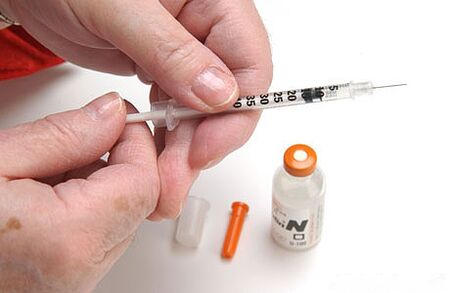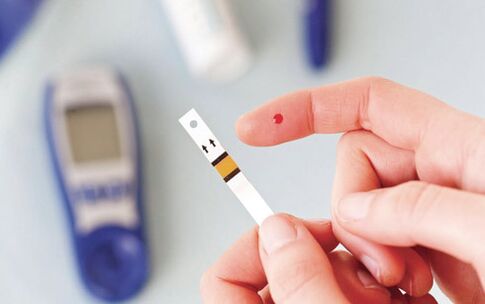Insulin - The hormonal secret of the processor plays an important role, ensuring the constancy of blood glucose. Diabetes mellitus is a consequence of a deficiency of this hormone. Complications caused by the disease usually lead to death. The basic principles of diabetes treatment are stricts adherence to the diet, taking drugs or insulin injections, tracking the blood level of glucose, observing your body so as not to lose the first signs of complications.

Pathogenesis of the disease
Diabetes mellitus is a persistent violation of insulin hormone synthesis and its interaction with body tissues.
Insulin processes the sugar received in glucose and passes through cell membranes. Thus, the hormone reduces the degree of blood sugar and provides cell nutrition. Insulin deficiency with impaired tissue sensitivity leads to the fact that glucose does not participate in metabolism and continues to circulate through the body. Biology not only carbohydrate metabolism is lost, but also fat, protein, salt.
The rise of sugar increases the amount of lipid fractions in the bloodstream, which contributes to the development of atherosclerosis. The transformation of glucose into glycogen decreases and the body begins to use fat as resources. Fatty acids break and ketone bodies appear that cause damage to the central nervous system.
Causes and current
Insulin production is disturbed due to damage to beta cell synthesization. The main risk factor for diabetes is heredity, which significantly increases the effect of other factors. The probability of getting sick increases with age. The Causes of Diabetes:
- The failure of the immune system. Causes cell attack with a protective protein pancreas.
- Obesity. Reduces the reaction of the receptors to the hormone due to excess adipose tissue (the cause of the type of diabetes).
- Pancreatic disease. Call cell death secreting the hormone (pancreatitis, cancer).
- Virus infection (varicella pathogens, rubella, influenza).
- Nervous tension.
The disease exists in the role of independent pathology and as a temporary symptom. The causes of diabetes mellitus may be the consequences of the errors of the work of endocrine organs (hyperthyroidism, feochromocytoma). The symptomatic excess of glucose detected during pregnancy (including the use of in vitro fertilization) is called gestational diabetes. Hyperglycemia occurs as a side effect of prolonged use of certain medications (glycocorticoids, estrogen, psychotropic drugs) when exposed to toxic substances.
Hyperglycemia signals diabetes only in the presence of insulin errors, the appearance of symptoms of sugar disease.
Diabetic pathology types

Diabetes mellitus is a violation of carbohydrate and water metabolism in the body.
Classification of those who determine two main types of disease: insulin dependent (type I) and the opposite form -Diabetes dependent on insulin (type II). They differ in reasons for the appearance and details of pathogenesis, the nature of the course, have their own characteristics of treatment, but the consequences are so dangerous.
- Insulin -dependent diabetes is caused by the autoimmune aggression of the body. The affected endocrine beta cells are not able to produce insulin at the necessary doses, their constant administration is required. People under 30, thin. The disease begins suddenly, quickly progresses and has a serious course.
- Insulinona -Dependent. The causes of this type's disease of diabetes are heredity and obesity. Insulin can be produced in sufficient quantities, but cells are not sensitive to it. This is due to an excess of nutrients. Diabetics over 40 have a complete physique. The acquired diabetes develops gradually, proceeds in a stable way. Most patients suffer from this type of disease.
Gravity
The severity of the development of diabetes mellitus in the blood glucose phase, glucosuria, the degree of target organs dysfunction, the presence of complications is determined, which shows the body's compensation capabilities. There are 4 degrees of gravity. If diabetes passes a mild degree, treatment and nutrition will be selected correctly. The degree of diabetes and symptoms is described in the table.
| Degree | Blood sugar, mmol/l | Urine readings | Symptoms |
|---|---|---|---|
| 1st (light) | No more than 7 | Protein is normal, glucosuria is absent | Absent |
| 2nd (half) | 7-10 | Glucose up to 40 g/l; Ketosis and ketatosis appear periodically | Cardiac activity, visual apparatus, nervous system, manifestation of angionaropathy |
| 3rd (heavy) | 10-14 | Persistent glucosuria 40 g/l, lots of protein, ketone bodies | Enhanced effect on organs, a drop in vision, pain and numbness in the legs, increased blood pressure |
| 4th (overpold) | 15-25 | More than 50 g/l of glucose, intense proteinuria and cetoacidosis | Strong defeat of all organs, kidney failure, coma diabetic, gangrene, ulcerative foci in the legs |
Characteristic symptoms of diabetes

Clinical signs of the disease in most cases are characterized by a gradual course.
Diabetes in adults may not declare immediately that it leads to the development of complications. Type I diabetes is developing rapidly with high blood glucose and coma. The intensity of the symptoms of acquired diabetes is associated with the degree of deficiency of insulin products, with the individuality of the patient's body. You need to go through a test to determine the degree of blood sugar if one of the symptoms appears:
- an unusual sensation of dry mouth;
- the inability to satisfy thirst;
- Improved diuresis - an increase in the amount of urine displayed;
- Fast weight loss or weight gain;
- itching and dry skin;
- Reduced sensitivity of the skin on the feet;
- numbness, tingling in legs and arms;
- seizures, gravity in the legs;
- purulent skin processes caused by slow skin regeneration;
- Low resistance to infections;
- constant feeling of hunger;
- vague view;
- Increased blood pressure;
- swelling of the face and legs;
- Head pain, passing out;
- Smell of acetone from the body;
- Darkening of consciousness;
- pseudo -peritrin (false "sharp stomach").
The consequences of blood glucose
Diabetes mellitus is an insidious disease. Excess blood sugar impairs blood vessels, causes damage to the wall. Excess glucose is transformed into fat deposits. This leads to obesity and steatogepatosis (accumulation of lipids in liver cells). Glucose causes membrane protein glycolization. The oxidative process is able to cause impaired protein to function and toxic appearance by products. Defective proteins cause disorders in organ structure. The accumulation of toxins and ketones causes damage to the patient's nervous system, even disturbances in mind and coma. Excessive blood cholesterol is based on arterial walls in damaged areas and forms atherosclerosis plaques, contributing to eye angiopathies, leg vessels and other organs.
The degree of excess blood glucose level determines the complexity of the course of the disease.
The risk of complications

Complicated diabetes mellitus carries the danger of a sick person's life, so it is so important to identify the disease over time and start treatment. The disease is aggravated for 10 to 15 years. Complications that appear progress quickly and it is not easy to deal with them. Acute complications with primary diabetes (hypo and hyperglycemia) are caused by sharp fluctuations in blood sugar. A list of states that complicate the disease of diabetics:
- Hypoglycemia - An accentuated drop in glucose less than 3 mmol/L can lead to a hypoglycemic coma.
- Hyperglycemia - Raising the sugar indicator above 6 mmol/L ends with a hyperglycemic coma.
- Ketoacidosis - damage to neurons with ketone bodies, causing someone.
- Neuropathy - Damage to the nerves of the periphery.
- Diabetic foot, trophic ulcers and lower ends terms caused by angiopathy and neuropathy.
- Nephropathy - Damage to the small chain capillaries, which interrupts the functioning of the urinary system.
- Retinopathy - thinning of the vascular walls of the retina.
- Cardiomyopathy - Cardiac muscle disorders.
- Encephalopathy - Pathology in cerebral vessels.
Diagnosis
The diagnosis of diabetes determines the type of disease, severity, presence of injuries from internal organs. Studies can be performed repeatedly to evaluate the degree of disease progress and the effect of treatment. Diagnostic criteria for diabetes are characteristic signs of diabetes and the degree of glucose survey. To confirm the diagnosis, urine and blood tests, instrumental studies are performed:
- Glucose indications in the empty stomach;
- Glycemic profile (daily vibrations);
- blood at an insulin level;
- A study of glucose tolerance, the proportion of sugar in the empty stomach and after carbohydrate consumption;
- Analysis for glycolized hemoglobin;
- Blood for biochemistry;
- General urine analysis detecting glucose, proteins;
- Electrolyte blood test;
- Acetone indicators in the urine;
- Ocular vision inspection;
- Rebel test for kidney damage;
- Abdomen ultrasound;
- Cardiogram to verify the function of the heart;
- Capillariescopy, reurcopy of the lower ends, determines the degree of defects in the vessels.
In healthy people, the blood glucose level is in the range of 3, 3 to 5, 5 mmol/l.
Disease treatment

In the presence of suspected diabetes mellitus, this diagnosis should be confirmed or refuted.
Diabetes mellitus is a chronic pathology that needs to be treated for a lifetime.
Diabetes Treatment Principles - Sugar Control in the bloodstream glyrometer and complication prevention observing the diet and taking drugs.
An endocrinologist can treat the disease, a cardiologist, a neuropathologist, an ophthalmologist, a vascular surgeon is connected.
Modern treatment methods - medicines, diet, physical education - slow down the progression of the disease.
Medication
The doctor selects the drug, given the type of disease. Type 1 diabetes mellitus requires only insulin therapy, type 2 diabetes can be treated with sugar. Pills act in the pancreas, increase the sensitivity of peripheral tissues. These medications are used:
- Sulfanillamides.
- Biguanides.
- Short and prolonged insulin preparations. Simple insulin is administered 3-5 times a day and long insulin up to 2 doses. Perhaps combined drug use.
Diabetes diet
Diabetes treatment certainly includes a diet with the selection of calorie content, excluding easily digestible carbohydrates. Diabetes requires fractional energy. At the same time, the proportion of nutrients remains close to the physiological. Sugar is replaced by xylitol or sorbitol. In medium and severe forms of the disease, diet # 9 is recommended. It is allowed to eat vegetable soups, types of fish and low fat meat, sour dairy products and cheese, cereals (sarracene wheat, barley oats), fruits, sweet and sour flavor berries. You can never eat sdoba, sweets, fatty dishes, rice semoline, pasta, grapes, salty and marinated vegetables.
Prevention
The occurrence of type 1 disease cannot always be influenced as it can cause a viral pathogen. The reason for the development of type 2 diabetes is considered a harmful lifestyle, especially in people with hereditary prerequisites. Prevention measures If sugar disease is diagnosed: adequate nutrition in small portions with minimal carbohydrates and fat easily digestible, maintaining the body weight ideal. Hypertension is also performed with control of blood pressure numbers. Periodically you need to donate blood to the glucose content and lipid blood fractions. Moderate physical activity will help keep the body in tone.























